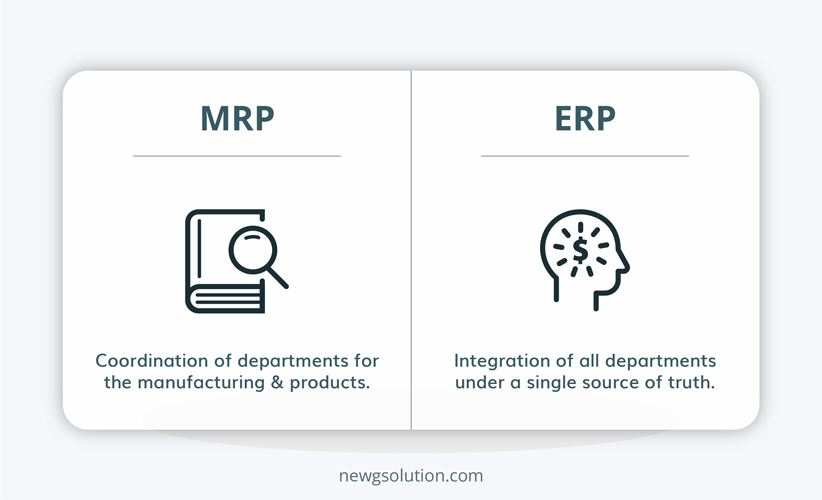The Origins and Future of Enterprise Resource Planning “ERP History”
eCommerce
LAST UPDATE: MAY 17, 2023
6 minutes reading
Although ERP systems have been around for a long time in manufacturing, a great deal of confusion still exists about what exactly ERP Software is and how it works. If so, you’re not alone; the Enterprise Resource Planning (ERP) industry may be murky. It seems that every ERP vendor has a somewhat different take on what the term “ERP” means, and manufacturers who already use ERPs may give you conflicting accounts of the benefits they’ve seen.
Confused? In fact, these distinctions highlight one of the main characteristics that make ERP systems such potent business tools: their adaptability. By adapting to your unique business processes, an enterprise resource planning (ERP software) solution can help you boost productivity and expand. And just as your company is unique from the competition, so too should your ERP system be customized to your specific operations and requirements.
In this article, we’ll discuss ERP history and how they’ve progressed from its early days to its current state as a powerful corporate tool.
ERP History in Short
In the 1960s, J.I. Case, a producer of tractors and construction machines, collaborated with IBM to create what is widely regarded as the first Material Requirements Planning (MRP) system, which is where ERP history begins. Large manufacturers then developed their own MRP systems.
Early MRP systems helped firms to track inventory and production, but they were expensive to construct, required a staff of experts to maintain, and took up a lot of space. In order to better plan production runs, this aided producers in managing raw material acquisition and product delivery to the factory.
The 1970s saw a rise in the popularity of MRP systems, but until recently, only major corporations with the means to invest in research and development were able to employ them. A number of major software companies, notably Oracle and JD Edwards, eventually set out to make this software available to a wider range of organizations.
ERP History in Manufacturing:
The introduction of the first manufacturing resource planning II (MRP II) systems in the 1980s was a watershed moment in the development of enterprise resource planning (ERP Software). These more advanced tools helped with more than just stocking up on raw ingredients. MRP II systems improved production scheduling and improved communication between the various manufacturing departments.
It didn’t take long for companies in other sectors to catch on to what manufacturing had figured out.
ERP System Evolution
Enterprise Resource Planning systems have evolved significantly since their introduction in the 1960s. At first, computers were used to design “reorder point” systems that helped organizations manage their inventory. In the 1970s, Material Requirement Planning (MRP) was developed as a widely used approach for production planning and scheduling in industry. Over time, ERP systems have continued to evolve and revolutionize how businesses manage their processes.
In 2000, Gartner Group coined the term “ERP II” to describe web-enabled systems that could integrate information from the front- and back-office applications such as customer relationship management (CRM), e-commerce, and marketing automation (HCM).
This was a big step forward since more data going into the ERP system makes it simpler to spot problems, fix them, and seize chances for growth.
ERP Companies: A Brief Overview of Their Past
The evolution of enterprise resource planning (ERP) was shaped by more than just the technology of the time. As with every piece of software, ERP systems owe a great deal to the companies that created them.
Despite the fact that the SaaS model has made it possible for dozens of new ERP providers to enter the market, the four pioneers in this space that we’ve profiled here have had the greatest impact thus far.
The BAAN Company
BAAN, a Dutch firm established in 1978, entered the enterprise resource planning (ERP) market with the conviction that the internet is the “ultimate enabler,” a concept that is evident in the company’s approach to its software solution. They are renowned for their unrivaled cross-functionality across a wide range of business elements and have access to a unique tool, Orgware, which reduces delivery costs and has helped them establish themselves as a market leader in the defense and aerospace sectors.
JD Edwards & Co
As a provider of software for the IBM System “an early mini-computer utilized by many organizations before the turn of the century”, JD Edwards was established in 1977 in Denver, Colorado. With the release of their ERP system OneWorld, they aimed to provide a more adaptable option to the more rigid offerings that were previously available to many small and medium-sized businesses. In 2003, Oracle paid $1.8 billion to acquire the company.
SAP
Systems, Applications, and Products in Data Processing (SAP) were created in 1972 by a group of ex-IBM engineers in Germany to provide business software for large manufacturers. In 1992, they introduced the world to R/2, their first enterprise resource planning system. However, it wasn’t until the release of the following version of this program, R/3, that their entire market share skyrocketed, and they soon climbed to prominence as one of the major vendors in the industry, having over 17,000 users by 1999.
Oracle
Oracle, the current market leader, is rightfully regarded as a giant in the enterprise resource planning (ERP) sector. It has been in the ERP market since 1987 and is the second-largest software firm in the world after Microsoft. Because its database management software has acted as the foundation for other ERP systems, Oracle is both a partner and a competitor to these businesses. Their ERP system, Oracle Applications, has one of the largest portfolios of applications.
Enterprise Resource Planning’s Future
It might be challenging to identify lasting trends among the countless technological innovations introduced each year. The incorporation of artificial intelligence and machine learning into ERP appears to provide users with novel opportunities.
In theory, intelligent enterprise resource planning (iERP) solutions can employ cutting-edge data analytics to provide unprecedented foresight for multinational corporations operating on a worldwide scale.
Several ERP companies have seen the effects of the proliferation of IoT devices. iERP could achieve unprecedented integration and agility by connecting directly production and distribution devices to the centralized database provided by ERP systems, and then automatically communicating to warehousing, procurement, and production units according to information received from other integrated software like CRM.
In Conclusion,
Modern ERPs are comprehensive, all-encompassing platforms that link your company’s various divisions and functions. Current ERPs give businesses a potent, always-on tool that manages a centralized data store that is accessible to all divisions.
Modern ERPs are also highly adaptable, and suppliers provide a wide range of tools, features, and functionalities tailored to the specific requirements and difficulties of many industries.
In addition to traditional ERP features like MRP, SCM, and FP&A, modern ERP software may also contain BI and reporting tools, marketing automation, CRM management, and project management tools.




Recent Comments